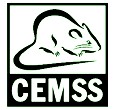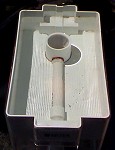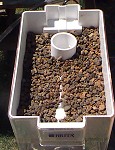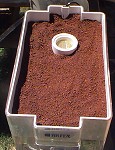 |
Controlled Ecological |
How It Works:   Making use of the unique design of a common plastic drinking water filtration system, (left), the CEMSS hydroponic growing trays sit "inside" the nutrient solution tank, which is slightly wider all around and about twice as deep. Removing the filter holder leaves a depressed "socket" just the right size for a 1.5" PVC straight junction pipe. This had a 1/2 hole drilled in the side to accomodate a 90 degree plastic pipe fitting, which is connected to a small submersable pump. The pipe fitting is attached to a long PVC tube with hole drilled evenly along the sides, (above left), for a controlled release of solution, (Above right; from Bradley Hydroponics of Corvallis, Oregon). Making use of the unique design of a common plastic drinking water filtration system, (left), the CEMSS hydroponic growing trays sit "inside" the nutrient solution tank, which is slightly wider all around and about twice as deep. Removing the filter holder leaves a depressed "socket" just the right size for a 1.5" PVC straight junction pipe. This had a 1/2 hole drilled in the side to accomodate a 90 degree plastic pipe fitting, which is connected to a small submersable pump. The pipe fitting is attached to a long PVC tube with hole drilled evenly along the sides, (above left), for a controlled release of solution, (Above right; from Bradley Hydroponics of Corvallis, Oregon).An initial layer of course cinders is laid down to cover the solution delivery system, and to make it easier for the solution to drain back when the pump cycles off. The finer-grained Santiam Mars Soil Simulant fills out the tray. A sandwich of fine mesh screen between a pair of thin PVC pipe sections tops the unit off as an over-flow drain, to capture any stray chunks of the Soil Sim.
 Every hour for five minutes, a small air circulation fan system will switch on as well, moving warm & moist oxygen-rich air from the growth chamber through the HVAC unit for cooling and dehumidification, then into the mouse hab, displacing the carbon dioxide, which is forced back in to the growth chamber by a pair of small 'button fans'. A sliding door separates the mouse hab from the growth chamber. The mouse will be allowed access at night, with a wire cage surrounding all but the fruiting heads of the crops, (right, at 4 weeks of growth) allowing the mouse to "harvest" its food while not killing the plants. Every hour for five minutes, a small air circulation fan system will switch on as well, moving warm & moist oxygen-rich air from the growth chamber through the HVAC unit for cooling and dehumidification, then into the mouse hab, displacing the carbon dioxide, which is forced back in to the growth chamber by a pair of small 'button fans'. A sliding door separates the mouse hab from the growth chamber. The mouse will be allowed access at night, with a wire cage surrounding all but the fruiting heads of the crops, (right, at 4 weeks of growth) allowing the mouse to "harvest" its food while not killing the plants.The MSOR/OPEN CEMSS Module uses hydroponics supplies from Bradley Hydroponics of Corvallis, Oregon. |





